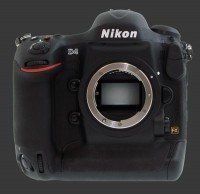Nikon D4 Review
Nikon D4 Usability - How easy is it to use?
The Nikon D4 is designed for efficiency with a huge number of controls and highly customizable interface. Its ergonomics are refined and will be familiar to users of previous Nikon DSLRs of the same class. Newcomers may find two aspects intimidating: the size of the D4 and the number of controls it has.
The large body of the D4 can be held both horizontally and vertically while maintaining access to two control-dials, an 8-way joystick and at least two customizable buttons. In the standard horizontal orientation, there is also an 8-way controller and additional buttons within easy reach.
In hand, the Nikon D4 feels substantial and heavy, particularly with a high-end lens attached. A large camera strap is provided but it takes time to get used to carrying such a camera. After that, most cameras, including other high-end DSLRs, seem too light! The grip for horizontal shooting is excellent and provides a very solid support for the camera. The vertical grip is good but not as deep. Still, photographers should usually hold the lens which relieves pressure from the grip.
This professional DSLR is extremely solid with every part, including the battery and memory-card compartment doors, other than rubber flaps over connection ports feeling durable. Dual actions for each compartment doors also means that neither can open accidentally. It is no surprise that there is a metal tripod mount directly in-line with the center of the lens.

There is one shutter-release on each grip, each with short travel and a soft halfway point. This makes it easy to shoot quickly without jerking the camera. The lower shutter-release can be locked by the rotating switch around it to avoid shooting accidentally. A small unmarked button behind it can active one of 26 functions, including EC and ISO, the two most likely candidates. To only way to access both settings vertically is to set the unmarked button to ISO and enable Easy EC which binds Exposure-Compensation to the unusual dial, depending on the exposure-mode. This is unfortunately accident-prone since EC may be inadvertently applied.
The top of the camera has three buttons behind the shutter-release. The closest is a tiny Video Record button marked with the universal red dot. This button can be assigned one of 4 functions in Stills mode. The most useful is certainly ISO and this makes it easy to change sensitivity with the camera at eye-level. Slightly behind, yet easy to reach, is the EC button.

The Nikon D4 uses a modeless button to select from standard PASM exposure-modes, rather than a traditional mode-dial. The chosen mode is shown in the viewfinder status line and the top status LCD. Memory banks can set the camera to any exposure-mode this way.
A cluster of three buttons are found on top of a slim drive-mode dial. The buttons control, Flash, Metering and Bracketing. Changing flash settings obviously has no effect unless a flash is attached to the D4 as there is no built-in flash. Flash-Compensation is applied by rotating the font control-dial while holding the flash button. Doing the same with the rear dial cycles over flash modes. Metering options are selected by rotating the rear control-dial while holding the metering button.
By default, the Bracketing button controls Auto Exposure Bracketing. When pressed, the front control-dial sets increments and the rear one selects the number of frames. Not all combinations of increments and frames are possible. The widest bracket is obtained with 3 EV increments for 5 frames. A menu option can change the type of bracketing to AE & Flash, Flash Only, WB and Adaptive D-Lighting. Possible increments and frames change according to the type of bracketing. The Bracketing button can instead be configured to activate HDR or Multiple-Exposures.
Even with its huge body, the back of the Nikon D4 is covered with buttons around an extra-large 3.2" LCD with 920K pixels. Below the main LCD, is a monochrome status display which is optionally backlit. This one shows Image Size, Image Quality, Memory Setup, White-Balance, Voice Memo Setup, plus ISO or other information which can take its place.
The LCD is bright and sharp with a good anti-reflective coating. A special gel layer makes fog dissipate rapidly after it forms. The viewfinder eyepiece is particularly resistant to fog too and clears quickly.

There are 8 buttons to the left of the LCD and OVF, mostly arranged in a column. The top two buttons, Play and Delete, are easy to reach and work well together. Pressing Delete once prompts to delete the shown image. Pressing it again confirms and pressing Play cancels. This makes deleting each image from a single card efficient. NOTE: Deleting images from both cards could not be tested due to a distinct lack of XQD cards.
The column below those has six buttons: Menu, Picture Style, Zoom-In, Zoom-Out, OK and Info. These buttons work intuitively. Unusual for people unfamiliar with similar models is the OK button. This is equivalent, most of the times, to pressing the center button of the directional-controller. Some functions only accept the OK button to avoid accidental use. In Playback mode, the Picture Style button locks and unlocks images. Pressing Info twice invokes the interactive status screen.
A row of four buttons are found below the rear status display:
- ISO: Pressing the ISO button, the rear control-dial sets the ISO, the front toggles Auto ISO on or off.
- Quality: Sets the file type and compressing with the rear control-dial and the image resolution with the front.
- White-Balance: Selects WB with the rear control-dial and adjusts it along the Blue-Amber scale with the front.
- Voice-Memo: Press it to start recording a memo for the last picture taken. Either hold while recording or press again when done, depending on a custom setting.
Below the main LCD and to the right of the rear status LCD is the Live-View button surrounded by a rotating switch. The button toggles Live-View, while the switch chooses between Still and Video mode. Video mode shows the right aspect-ratio for video and enables the Video Record button on top of the hand-grip. It also restricts shutter-speeds to less than the video frame-rate.
To the right of the LCD there is an impressive set of controls. At the top is the customizable already described AF-On button. Below it is a small joystick Called Sub-Selector. which easily moves the focus-point or focus-area around. The joystick can be pressed too. There are 20 options to choose from with only one having to do with the focus-point: Reset to center-point. Putting something unrelated, such as the Virtual Horizon, makes for an odd control but can be useful.
Below the joystick is an 8-way controller with central button. This one also moves the focus-point and has an option to Reset the Standby Timer or not. The central button can optionally reset the focus-point in standard shooting mode. In Live-View it can reset the focus-point or magnify the view. In Playback mode, it can toggle thumbnails, view histogram, magnify or choose memory card and folder. The Histogram option is genuinely appreciated. It lets you quickly display a histogram while reviewing an image and it disappears instantly when letting go. The remaining options for the joystick and controller are frankly twisted, always leaving these controls under-used. A locking lever below the 8-way controller locks it and the 8-way joystick to prevent accidents.
There is a second 8-way joystick to use with the vertical grip. It does exactly the same things as its twin. There is also a second AF-On button which can do the same as the first or be configured independently from the same set of options.
Unlike previous Nikon DSLRs, the D4 shows both digital-level axis in the viewfinder. The way they are displayed is odd though. One axis is displayed to the left of the image using the EC scale. The other is displayed using the AF-points. Which axis is witch depend on which orientation the camera is being held. Holding it horizontally, tilt is shown using the AF-points and pitch using the EC scale. The converse happens when holding the camera vertically. Because the digital-level reuses existing indicators, it has to be toggled. When the AF-point is moved, the level display stops but when EC is applied, it does not.
In the viewfinder there is also a status line below the view. It shows Metering, Exposure-Mode, Shutter-Speed, Aperture, ISO and the number of frames remaining, plus some status icons such as AE-L when exposure is locked. This clearly shows all the most important information. It also has a great MF direction indicator that shows in which direction the lens needs to be focused. It also confirms when focus has been established at the center of the frame.

There are several controls on the front of the camera. Near the base of the lens mount is the focus controller which configures the highly versatile 51-point autofocus system of the Nikon D4. The outer part of the switch rotates between AF and MF mode. At the M position, AF is obviously disengaged and no further AF functions apply. At the AF position, the central button enables the front control-dial to set the focus-point selection mode and the rear one to set the focus-drive mode.
There are three focus-drive modes, AF-S which is single-shot autofocus, AF-C which is continuous autofocus and AF-A which automatically switches between the two other modes depending on subject movement. There are six focus-point selection modes with only the first two available in AF-S:
- Auto: The camera automatically selects among its 51 AF points and highlights all those in focus.
- Single-Point: The user selects a single point among all 51 using the 8-way controller on the back of the camera. Pressing the central button resets focus to the center point.
- 9-Point Dynamic Area: The user selects one point among all 51 and the camera tries to keep the subject in focus at one of the 9 closest points.
- 21-Point Dynamic Area: The same thing except that the camera tries to keep the subject in focus at one of the 21 closest points. There is greater risk of focusing on the wrong subject while allowing to follow faster movement.
- 51-Point Dynamic Area: Again the user chooses a single point but the camera looks at all 51 points to focus on the subject. The camera can more easily focus on the wrong subject but it can handle erratic motion.
- 3D Predictive Tracking: The camera locks onto the subject under the selected focus-point and follows it around the frame.
The last two buttons on the front are on the other of side of the lens mount. The top one is Pv which stands for DOF-Preview, its default function. The bottom one is simply Fn for Function. Each button can take on any one of 23 functions: DOF Preview, FV Lock, AE/AF-L, AE-L, AE-L Auto-Release, AE-L Hold, AF-L, AF-On, Flash Off, Bracket Burst, Matrix Metering, Center-Weighed Metering, Spot Metering, Playback, My Menu, My Menu Top-Item, Virtual Horizon1 EV Step, Non-CPU lens or Playback.
Customizing one of these buttons is the only way to access DOF Preview, so that would be the most common assignment. Another great customization is to set one to My-Menu Top-Item and make the top item Exposure Delay Mode. For tripod users without a remote, this the one of the best options.
Live-View is poorly implemented. Many photographers could not care less but video depends on it. The main problem is that the view is not Exposure-Priority. This DSLR makes no attempt to preview a correct exposure. It does not respond to EC and there is no live histogram either. The set aperture is sometimes used to show the correct depth-of-field but not always. The DOF preview is also ignored.
The main usability complaints are a hidden Exposure Delay Mode and poor digital-level experience in the OVF. At least the delay mode can be set as the first item in My Menu and then one of the front buttons can jump to it directly. Considering how much the Nikon D4 does well, these issues are minor.
 |
Please Support Neocamera
All information on Neocamera is provided free of charge yet running this website is a huge endeavor. Purchases made via affiliate links found throughout the site help keep it running and up-to-date. There is no additional cost to you, so please consider buying via these links to our affilates:
If you found any information on this site valuable and did not purchase via our affiliate links, please considering donating via PayPal:
Any amount will be greatly appreaciated. Thank you for your support!
Nikon D4 Highlights

Sensor-Size: 36 x 24mm

Actual size when viewed at 100 DPI
| 16 Megapixels DSLR | ISO 50-204800 |
| Nikon F Mount 1X FLM | Shutter 1/8000-30s |
| 100% Coverage Extra Large Viewfinder | Full manual controls, including Manual Focus |
| 2 Axis Digital Level | Custom white-balance with 2 axis fine-tuning |
| Weatherproof | Spot-Metering |
| Built-in Dust Reduction | Hot-Shoe & Sync-Port |
| 11 FPS Drive, 170 Images | Stereo audio input |
| 1920x1080 @ 30 FPS Video Recording | Lithium-Ion Battery |
| 3.2" LCD 920K Pixels | Compact Flash Type 1, XQD |
Updates
2025.01.18

Fujifilm GFX 2025 Lens Roundup
Lens Review roundup of Fujifilm GFX Medium-Format lenses. Quality, performance and handling of the GF20-35mm F/4R WR, GF30mm F/3.5 Tilt-Shift and the GF55mm F/1.7.
2024.11.18

Best 2024 Photography Gifts for Every Budget
Great gifts for photographers and photo enthusiasts selected for every budget among the best products of 2024.
2024.08.07

Eye Protection Tips for Professional Photographers
The four main considerations for professional photographers regarding eyewear.
2024.07.14

Fujifilm X100VI Review
Flagship fixed-lens compact digital camera with a 40 MP sensor and Image-Stabilization, a first for the series. Retro design featuring dual control-dials, plus direct ISO, Shutter-Speed and EC dials. Its hybrid viewfinder can switch between EVF and OVF mode.
2024.05.09

Fujifilm GFX100 II Review
Flagship 102 Megapixels Medium-Format Mirrorless Digital Camera with 8-Stop 5-Axis IBIS, 8 FPS Drive, 8K Video and 400 MP Super-Resolution capture in a weatherproof and freezeproof body with dual control-dials and dual memory-card slots.
2024.04.03

Fujifilm X-T5 Review
Newest Fujifilm flagship boasting a 40 MP APS-C sensor, 5-axis IBIS with 7-stop efficiency, 15 FPS continuous drive, 6.2K Video capture, dual control-dials and dual SDXC UHS-II slots in a sturdy weatherproof and freezeproof body.
2023.11.20

Best Digital Cameras of 2023
Find out which are the Best Digital Cameras of 2023. All the new Mirrorless Digital Cameras from entry-level to high-end professional.
2023.07.10

Fujifilm X-H2 Review
40 Megapixels APS-C Hybrid Mirrorless Digital Camera with 7-stop IBIS. Fastest shutter ever and 8K video capture. Large builtin EVF with 0.8X magnification and 5.8 MP, plus an Eye-Start Sensor. Packed with features and large number of controls in a weatherproof and freezeproof body.
2023.05.07

Sony FE 20-70mm F/4G Review
Review of the unique Sony FE 20-70mm F/4G lens. The optical zoom of this lens spans ultra-wide-angle and medium focal-length coverage, making it one of the most versatile Full-Frame lenses on the market.
2023.01.15

Huion Inspiroy Dial 2 Review
Review of the Huion Inspiroy Dial 2 tablet, a medium sized drawing surface with dual dials and customizable buttons. Connects via USB-C or Bluetooth 5.0 with Windows, Linux and Android support.
2022.12.08

How to Pack for a Photo Trip
Find out how to pack for a travel photography trip, carry your gear safely while meeting airline regulations.
2022.11.13

Best Digital Cameras of 2022
The best digital cameras of 2022. A short list of the most outstanding models in their respective categories. Choose one for yourself or as a gift.













